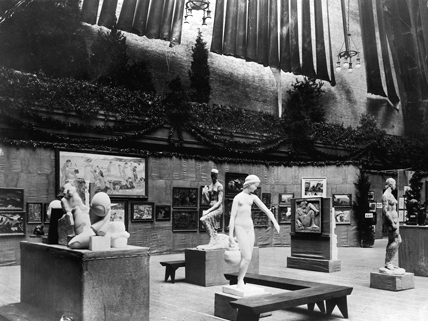This photo was taken at the original 1913 Armory Show.
These days, the art world is not easily shocked; shock is commonplace, made into its own genre. A dead shark displayed in a tank of formaldehyde? A skull covered with diamonds? Ho-hum. (Yes, those are real works, by British artist Damien Hirst.) But 100 years ago, a controversial art exhibit shocked not just the art world, but also American society.
On February 17, 1913, the International Exhibition of Modern Art opened in New York City’s 69th Regiment Armory. Commonly called the Armory Show, the exhibit introduced Americans to cutting-edge artistic styles. Among those styles were Fauvism, Cubism, and Futurism. To people accustomed to realistic art—a painted tree looks like a real tree, a sculpted face looks like a real face—the abstract works displayed represented a radical change. In fact, news stories about the show used words such as quackery, insanity, immorality, and anarchy in their reports. Parodies, satirical cartoons, and caricatures of the works abounded. Even former president Theodore Roosevelt expressed an opinion, declaring, “That’s not art!”
One work that many people found particularly disturbing was Nude Descending a Staircase, No. 2 by French artist Marcel Duchamp. The Cubist painting breaks the figure into a progression of geometric shapes, the “nudity” being all but undetectable. One critic dismissed it as “an explosion in a shingle factory.” Another of the most scandalous works was Madras Rouge (Red Madras Headdress) by Henri Matisse. Although the woman in the headdress is recognizable as a human female, her features are sketched in, and blocks of color take up much of the canvas.
In spite of the hubbub, the Armory Show was a big success, and it traveled to other U.S. cities. In 2013, at least two exhibitions are celebrating the show’s centennial. The Smithsonian has created an online time line of events surrounding the original exhibition. Take a look through the online sources to see what shocked Americans a century ago. Why do you think these artworks were so controversial?
Image credit: © Betmann/Corbis
Related Links
-
“Armory Show” That Shocked America in 1913 Celebrates 100
Read here why one critic described a painting as “an explosion in a shingle factory,” listen to the story, and see for yourself Nude Descending a Staircase (No. 2).
(Source: NPR, February 17, 2013) -
Madras Rouge
Why was Matisse’s portrait of his wife so shocking? See what you think.
(Source: Wikipedia; accessed February 28, 2013) -
1913 Armory Show: The Story in Primary Sources
This site has a wealth of letters, newspaper articles, cartoons, postcards, and other documents related to the Armory Show.
(Source: Smithsonian; accessed February 28, 2013) -
The New Spirit: American Art in the Armory Show, 1913
This New Jersey exhibit focuses on the American artists represented in the original show.
(Source: Montclair Art Museum; accessed February 28, 2013)




